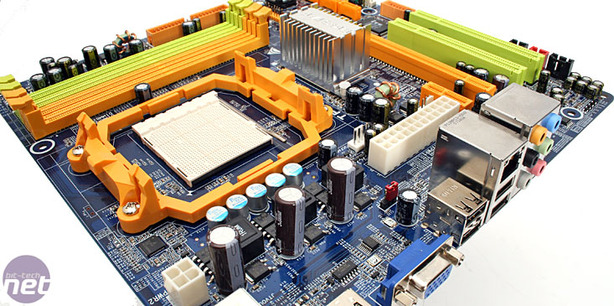Memory
Four memory slots are included which gives you greater expansion potential than the MSI K9AGM2’s (AMD 690G) two. It means you can throw in two or four 512MB sticks if you’ve got hand-me-downs, or simply because they're cheaper.Alternatively, you can throw in 4GB of memory using four 1GB modules - a far cheaper solution than having to invest in two 2GB sticks. Having said that though, you're unlikely to need that much memory in a home theatre PC.
The memory channels are colour coordinated for ease of use. For dual channel operation, you need to install two modules in adjacent slots of the same colour.
Cooling
Despite integrating both southbridge and northbridge into a single chipset, no fancy heatpipes are needed; instead, there's just a small fanless heatsink. There’s enough space around the CPU heatsink for large coolers, although the northbridge heatsink and three tall capacitors are relatively close to the socket.Power sockets, connectivity and pin outs
The 4-pin 12V CPU power socket may be well placed at the top of the board, but the 24-pin ATX socket is extremely poorly positioned on the inside edge which can inevitably cause cable routing problems. The three USB pin-outs for six ports are also coloured orange like many other ports, but this isn’t a problem seeing as they are clearly placed away from every other pin-out, which congregate in a line just above the PCI-Express x16 slot at the edge of the board for ease of use.
There are also legacy pin-outs for serial (green) and parallel (purple) ports but no PCI brackets provided to make use of them. The same goes for the S/PDIF pin-outs which actually get proper keyed plastic shrouds as well. The HD audio pin-out just gets the plain old ambiguous black plastic treatment, but the front panel pin-out connectors are colour coded for ease of identification and placed in a far better position at the bottom corner.
Biostar even includes on-board power and reset switches on the TF7050-M2, which is great for bench testers and for when you’ve installed your stuff in a new case and maybe want to check its all working correcting. It’s a simple addition, but deceptively useful in some scenarios.
Sound
Realtek ALC888 is the High-Definition audio codec of choice. Even though it doesn’t support protected content like the ALC885 or 889a, it doesn’t matter since there is a BIOS option to select HDMI audio that gives it the required HDCP. With HDMI audio and HDCP enabled, the chipset doesn’t allow the user to use S/PDIF and other audio outputs since the content requires DRMIf you are just using the on-board sound for anything else, there are six 3.5mm stereo audio jacks: four of which are for the 7.1-channel High-Definition audio and two are dedicated for line in and a microphone. In addition, there are the previously mentioned S/PDIF in and out pin-outs and front panel audio pin-out.
Ethernet
There is one Gigabit Ethernet provided by the PCI-Express based Realtek RTL8111B chipset that serves the single RH45 socket on the rear I/O. No other WiFi or Ethernet connections are provided but the variety of PCI-Express, PCI and USB connectivity should allow for enough expansion potential. Gigabit Ethernet over PCI-Express should also be more than enough to stream HD content over a LAN as well, unlike any current home wireless technology.
MSI MPG Velox 100R Chassis Review
October 14 2021 | 15:04









Want to comment? Please log in.